Large parts of the country saw snowfall on Saturday and Sunday with 40–70 centimetres falling in the south-eastern canton of Graubünden.
The highest snowfall in Graubünden – 73 centimetres – was registered in St. Antönien while the cantonal capital of Chur registered 25 centimetres.
Many parts of the Swiss plateau were also blanketed, but western Switzerland, Valais and north-western Switzerland saw no new white stuff.
Wo ist das Auto? Rund 40 cm Neuschnee auf der #Schwägalp. Wir wünschen #SRFAugenzeuge Stephan Lendi viel Spass beim Freischaufeln. ? ^jz pic.twitter.com/i6EP4tOcuZ
— SRF Meteo (@srfmeteo) January 6, 2019
Police received numerous reports of traffic accidents although most did not result in injury.
.jpg)
An accident in Rapperswil-Jona. Photo: St Gallen Cantonal Police
In the canton of Aargau, a salt spreader tipped over, as can been seen in the image below.
#Hägglingen #Unfall Selbstunfall eines Salzstreu-Lastwagens. Fahrer leicht verletzt. Bergungsarbeiten dauern noch an. pic.twitter.com/KUU4vKJGo3
— Kapo_Aargau (@Kapo_Aargau) January 5, 2019
Meanwhile, Switzerland’s Italian-speaking canton of Ticino enjoyed spring-like conditions with temperatures around 15 degrees.
The Locarno-Magadino weather station registered an overnight temperature of above 11 degrees on Saturday to Sunday – the highest January minimum since records began in 1959, according to private weather service MeteoNews.
A cold week is now expected north of the Alps, while it will continue to be bright in Ticino with temperatures around 10C.
The avalanche risk remains elevated across the Alps. Two people died in separate avalanches late last week.




 Please whitelist us to continue reading.
Please whitelist us to continue reading.